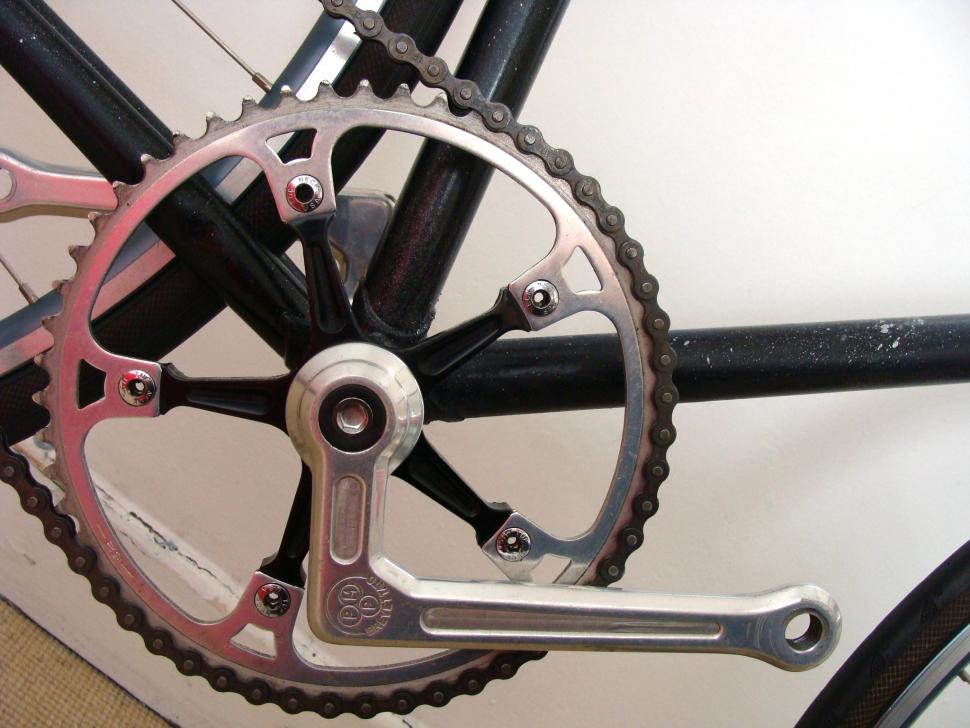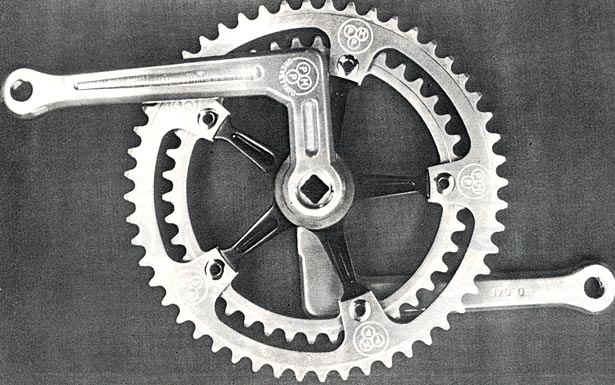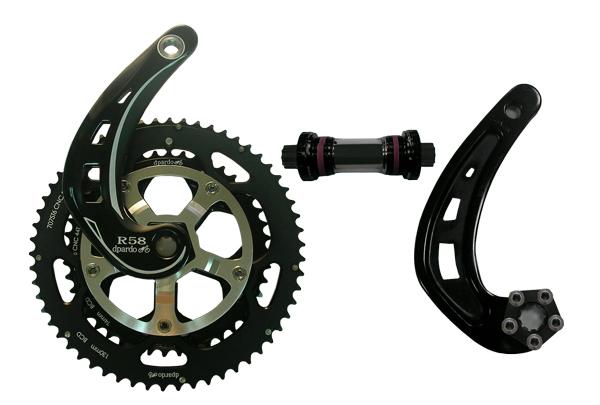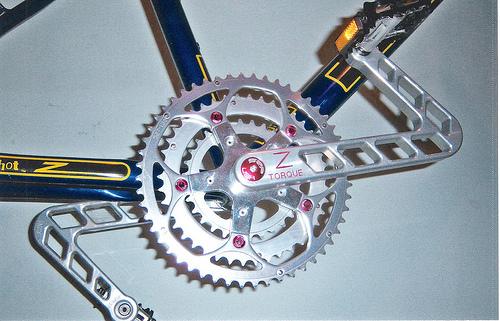- News
- Reviews
- Bikes
- Accessories
- Accessories - misc
- Computer mounts
- Bags
- Bar ends
- Bike bags & cases
- Bottle cages
- Bottles
- Cameras
- Car racks
- Child seats
- Computers
- Glasses
- GPS units
- Helmets
- Lights - front
- Lights - rear
- Lights - sets
- Locks
- Mirrors
- Mudguards
- Racks
- Pumps & CO2 inflators
- Puncture kits
- Reflectives
- Smart watches
- Stands and racks
- Trailers
- Clothing
- Components
- Bar tape & grips
- Bottom brackets
- Brake & gear cables
- Brake & STI levers
- Brake pads & spares
- Brakes
- Cassettes & freewheels
- Chains
- Chainsets & chainrings
- Derailleurs - front
- Derailleurs - rear
- Forks
- Gear levers & shifters
- Groupsets
- Handlebars & extensions
- Headsets
- Hubs
- Inner tubes
- Pedals
- Quick releases & skewers
- Saddles
- Seatposts
- Stems
- Wheels
- Tyres
- Health, fitness and nutrition
- Tools and workshop
- Miscellaneous
- Tubeless valves
- Buyers Guides
- Features
- Forum
- Recommends
- Podcast
 PMP cranks 2.jpg
PMP cranks 2.jpgL-shaped cranks — explore the crazy idea that just won't die
Image: PMP cranks by robadod from LFGSS [This feature from the road.cc archive was last republished on October 15, 2020]
We take a look at one of the more bizarre technical aberrations of recent history: the wackiest cranks ever made.
In 1981 Cycling Weekly magazine published a favourable review of an unusual new crank. The magazine gave a set to “a first-category Surrey roadman to try them out.”
The write-up said: “He fitted them in March and although our test is now over they are still on his best road bike. He has come to prefer them to orthodox cranks.”
CW’s tester “enjoyed the ‘feel’ of the cranks and reported that the slower his pedalling speed the more advantage he felt, which is perhaps why they are finding favour with big-geared time triallists.”
The tester told CW: “I didn't just get the power on the downward strokes of the pedals but all the way round the pedalling revolution as at low pedalling speeds dead centre seemed to be removed. This helped me keep a steady rhythm particularly when sitting back in the saddle climbing hills.”
He didn’t feel the same benefit when pedalling quickly in a low gear, though.
CW concluded: “So there is the verdict, whatever the theories, in practice our roadman tester felt the PMP cranks offered an advantage – and surely that is the true criterion.”
That crank was the PMP Brevettato. Its unusual (but, as we’ll see, by no means unique) feature was a right angle bend about a third of the way between the bottom bracket axle and the pedal.
PMP made some interesting claims about the Brevettato cranks. They included:
- The unique form of the PMP pedal crank means improved distribution of the energy required in pedalling and a perfectly round stroke; the result: increased equilibrium.
- Its L-shaped design increases the pedal's propulsion power and lessens energy dispersion on the downstroke.
- Pedalling the PMP way means to be perfectly in the saddle; in fact, the bicycle rider is forced to lean back slightly more than usual, putting him in the best possible aerodynamic position.
- The PMP pedal crank means that pedalling is no longer an "ankle game" since the bottom dead-point is lightened to allow greater ease on the upstroke.
- Bicycling becomes a pleasure and not a chore because the PMP pedal crank and its unique features take away the exertion and lighten muscle strain.
Bold claims, and with Cycling Weekly’s Surrey roadman finding they eliminated dead centre, you have to wonder why the design isn’t now ubiquitous.
That’s simple: it’s all bollocks.
A crank is a lever. The torque you generate when you load up the end of a lever depends on just two things: the force you exert and the distance between the point where that force is applied and the pivot.
Nothing else matters, especially not the route the lever takes between the two points. It can be a straight line, a right angle bend or any other shape; it doesn’t matter. All you achieve by making a crank any other shape than straight is to add weight and flexibility.
PMP cranks were even marked with the distance between the crank and pedal holes. As the Bicycle Museum of Bad Ideas remarks: “somebody at PMP understood it was simply an odd way to make a 175mm crank”.
Pretty much everyone who was paying attention in physics at school pointed this out at the time, but that didn’t stop a fad for PMP Brevettatos, especially among time triallists.
Even the great 80s time triallist Ian Cammish used them. Cammish, who won the Best British All-Rounder contest nine times in the 1980s, mentioned them when he tried to sell one of his 1983 bikes on eBay in 2013.
“Unfortunately the PMP cranks cracked a long time ago,” he wrote.
They had a bit of a reputation for that, though to be fair so did many other high-end cranks of the era.
Perhaps because of these reliability issues, and because not many were made in the first place, PMP Brevettato cranks are now rare and collectible. The most recent set I’ve seen on eBay went for US$400 — almost £300.
Other wonky cranks
The bike industry has a serious problem with knowledge loss, which leads to people who really should know better reinventing bad ideas over and over. The PMPs weren’t the first non-straight cranks (the earliest seem to have been in 1897), nor the last. Like the monster lurching back to life at the end of a bad horror movie, wonky cranks keep coming back.
Want to make people go “What the hell?” get yourself a set of dpardo Sickle Cranks:
It’s not at all clear what advantages dpardo claimed for this design. PMP had a slight case of ‘Campagnolo spoken here’ Italglish, but dpardo really needed to get a native speaker of English to write its marketing copy. It says — and I swear I haven’t changed a letter of this:
58T gear turns once is 1.6M faster than 50T!As same as pedaling 50T !Same pedaling force pedal 58T, the riding performance is 16% increasing than 50T with normal cranks
The craziest recent reappearance of wonky cranks has to be Z-Torque cranks, which came and went between 2010 and 2014.
The shape was claimed to have come to inventor Glenn Coment in a dream. He bent a wire coat hanger into the same shape and “when he revolved it in his hands he found that this crank assembly was different from any other crank assembly ever made. Except for top dead center and bottom dead center, this crank had no dead spots. He was amazed. And in future testing would find that during a rider's maximum effort, power increases at a bikes rear wheel of 20-25% were possible.”
If true, that would be little short of astounding.
Z Torque further claimed “many advantages, including”:
- Smoother pedaling
- More power to climb hills
- Less perceived effort to pedal
- Faster acceleration
- Less affected by headwinds
- Ability to turn higher gearing
However, the Z Torque was really just another crank that connected the bottom bracket axle and pedal by a circuitous route, with an extra problem baked in.
As you can see, the long arm of the V shape, is really, really long. Imagine trying to pedal while banked over hard in a corner and you can probably explain why Z-Torque cranks were never even as popular as PMP Brevettatos.
John has been writing about bikes and cycling for over 30 years since discovering that people were mug enough to pay him for it rather than expecting him to do an honest day's work.
He was heavily involved in the mountain bike boom of the late 1980s as a racer, team manager and race promoter, and that led to writing for Mountain Biking UK magazine shortly after its inception. He got the gig by phoning up the editor and telling him the magazine was rubbish and he could do better. Rather than telling him to get lost, MBUK editor Tym Manley called John’s bluff and the rest is history.
Since then he has worked on MTB Pro magazine and was editor of Maximum Mountain Bike and Australian Mountain Bike magazines, before switching to the web in 2000 to work for CyclingNews.com. Along with road.cc founder Tony Farrelly, John was on the launch team for BikeRadar.com and subsequently became editor in chief of Future Publishing’s group of cycling magazines and websites, including Cycling Plus, MBUK, What Mountain Bike and Procycling.
John has also written for Cyclist magazine, edited the BikeMagic website and was founding editor of TotalWomensCycling.com before handing over to someone far more representative of the site's main audience.
He joined road.cc in 2013. He lives in Cambridge where the lack of hills is more than made up for by the headwinds.
Latest Comments
- grOg 3 sec ago
Where does it state in the article that Ashley purchased the stock? it does state that Ashley bought the brand and intellectual property, not the...
- rogerwb 2 hours 40 min ago
Jump off the bike and run across. I cycle in trainers though.
- momove 3 hours 43 min ago
Cheers for the lesson! Wasn't expecting one so was pleasantly surprised, especially getting to find the origin of "laconic"!
- ktache 4 hours 30 min ago
Isn't it a rights issue?
- AidanR 5 hours 20 min ago
Same here - it took me by surprise. 10:30am doesn't feel like a dangerous time to cycle; apparently I'm wrong on that.
- Daddy Feebs 5 hours 33 min ago
If anything, it looks a bit like an SL6
- wtjs 6 hours 9 min ago
Other commenters have different views True!
- Daclu Trelub 6 hours 24 min ago
Incredibly bone-headed.
- Sriracha 8 hours 26 min ago
Lidl have a window poster emblazoned, "Black Friday. Starts Sunday".




Add new comment
109 comments
I'll plead innocent to that. I can't recall ever holding that opinion.
Thinking about it now, that would only make sense if you had really weak/flexible axle otherwise, the forces would be distributed across both sides equally.
This is the first time I've seen someone troll those of us who did A-level Physics. I'll bite. Have another think about how your weak/flexible (totally different properties) axle, contained in a stiff fork and with each end attached to a single wheel rim, could possibly cause a bicycle to pull left when that axle is braked at one end.
[/quote]
This is the first time I've seen someone troll those of us who did A-level Physics. I'll bite. Have another think about how your weak/flexible (totally different properties) axle, contained in a stiff fork and with each end attached to a single wheel rim, could possibly cause a bicycle to pull left when that axle is braked at one end.
[/quote]
Surely you can twist the fork legs under heavy braking due to the caliper only being on one leg.
I had a road bike where the fork legs were twisted and it gave the bike a tendency to steer one way so i had to hang a long way off one side to ride no handed.
Can't see how you'd affect the axle mind.
This is the first time I've seen someone troll those of us who did A-level Physics. I'll bite. Have another think about how your weak/flexible (totally different properties) axle, contained in a stiff fork and with each end attached to a single wheel rim, could possibly cause a bicycle to pull left when that axle is braked at one end.
[/quote] Surely you can twist the fork legs under heavy braking due to the caliper only being on one leg. I had a road bike where the fork legs were twisted and it gave the bike a tendency to steer one way so i had to hang a long way off one side to ride no handed. Can't see how you'd affect the axle mind.[/quote]
Well, it's not completely bonkers...
A disk brake calipers applies a force to the disk a small distance behind the axis of the left fork blade, with an equal but opposite force being applied to the caliper. As this is off-axis, it results in bending of the left fork blade roughly in a direction perpendicular to the axle, and the left side of the axle moves backwards, turning the wheel slightly to the left.
Then two things happen.
1. As forks have 'trail', ie the contact patch is behind the headset axis, the contact patch moves to the right of the bike's axis, which would create a tendency to turn to the right.
2. As the contact patch is no longer aligned with the bike axis, the bike starts to fall. In this case to the left.
3. The wheel is angled slightly left, which creates a tendency for the bike to move left, offsetting 1. above.
As for the result of 1, 2 & 3, plus no doubt something I have forogotten, I have no idea.
And in any case, I suspect the deflection is very small in any real-world bike not made of wet noodles, and completely dominated by other dynamic things such as rider balance, bumps in the road, that it's never actually noticed.
You're right - the axle shouldn't make any difference. I'll admit to having a few beers before posting that. Maybe in theory a weak flexible hub could deform with disc brakes but you wouldn't be riding with a wheel that behaved like that.
Also why the bottom bracket and crank must have as little flex as possible, the bike might dangerously pull to the right when sprinting.
I can't even imagine how Christian Haettich counters that. http://www.bbc.co.uk/news/magazine-30295759
I remember that thread, stopped commenting when whatever 'flatearther' came out with that as I couldn't be arsed banging my head into my dead horse.
That depends on which hemi-sphere you're in .... pulls to left in the north, to the right in the south. I have this on good authority.
No it couldn't.
It can change the relationship between the top dead center of the (oval) chainring with the top dead center of the foot on the pedal. Of course, a straight crank could be fitted in a different orientation with the crankshaft to achieve the same without all the problems of a non-straight crank.
Except there is a much better solution for that used by all modern oval rings - a series of bolt holes on the chainrings to interface with the crank arm at different angles. Never use any other material when the same can be accomplished with holes.
Exactly. That's why 'L' shaped cranks are completely useless.
Sheldon Brown on Shimano's non-round Biopace chainwheel of the 80s and 90s: https://www.sheldonbrown.com/biopace.html
maybe read the article again. You could connect the pedal and the crank with any shaped bobble you want and it wouldn’t make a lick of difference. It’s still just a fixed relationship between bottom bracket and pedal. Doesn’t matter what shape chainring.
Hmm. Magic wristbands, anyone?
*cough* ... Mr Thomas....
Sports people falling for snake oil ... well I never...
1. Pay attention in physics and avoid getting suckered by perpetual motion machines and other quackery.
2. Never underestimate the psychological power of the placebo effect. Tell enough people enough times in a convincing enough manner that sniffing a rat's testicles before a race will make them faster, and sure enough some will actually go faster.
3. Don't fancy sniffing a rat's testicles? I can supply homeopathic rat bollock odour at just £25 for 10ml, enough for a month's supply.
Do you accept Paypal?
Pages